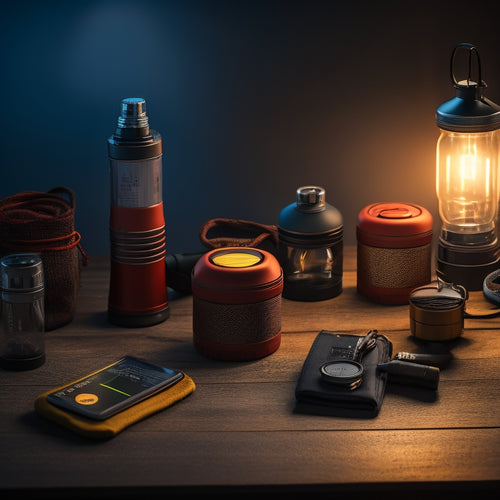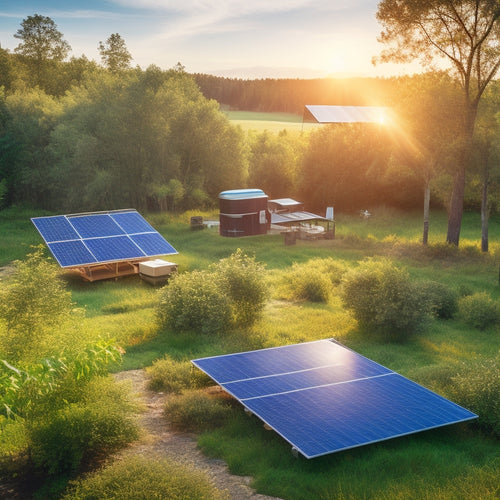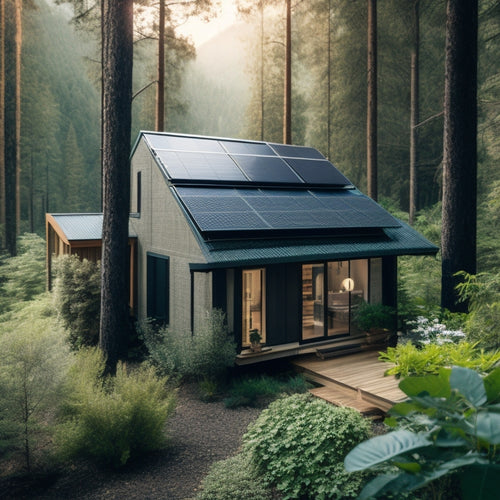
Top DIY Kit for Home Energy Independence
Share
To achieve home energy independence, you'll want an exceptional DIY kit that incorporates the best solar panel technology, energy storage solutions, and inverter types. For beginners, consider a starter kit with a 100-200 watt capacity, pre-wired and pre-assembled components, and essential tools like a drilling machine and multimeter. Don't forget to choose the right inverter type, such as a string inverter or microinverter, based on your system's size and layout. As you set out on this expedition, you'll uncover more about energy storage options, portable solar power systems, and maintenance tips that'll help you optimize your energy production and gain true independence from the grid - and there's more to investigate.
Overview
- Consider a DIY solar kit with a capacity of 100-200 watts, including essential components like an installation guide, mounting hardware, and a charge controller.
- Choose a kit with high-efficiency solar panels, a durable mounting system, and a top-rated inverter that aligns with your system size and layout.
- Look for pre-wired and pre-assembled kits to simplify installation, and evaluate the manufacturer's warranty and customer support.
- Assess your energy requirements to balance cost and performance, and consider energy storage solutions like batteries for optimal energy independence.
- Ensure proper installation and maintenance of your DIY kit to achieve optimal performance, energy savings, and a reliable home energy system.
Best Solar Panel Kit for Beginners
When venturing into the world of solar energy, selecting the right solar panel kit is essential for a successful shift to home energy independence.
You'll want to contemplate solar panel types, such as monocrystalline, polycrystalline, and thin-film panels, each with its own efficiency and cost benefits. As a beginner, a starter kit with a smaller capacity (100-200 watts) is recommended.
Look for a kit that includes an installation guide, mounting hardware, and a charge controller. A good installation guide should provide clear instructions and diagrams for a hassle-free setup.
Many kits, including WindyNation Complete Kit, are pre-wired and pre-assembled to simplify installation, minimizing errors and setup time.
Additionally, think about the warranty and customer support offered by the manufacturer. By choosing the right solar panel kit, you'll be well on your way to utilizing the power of the sun and achieving energy independence.
Top Portable Solar Power Systems
Your off-grid journeys or emergency preparedness plans require a reliable source of renewable energy, and that's where top portable solar power systems come in. These innovative solutions offer the freedom to generate power anywhere, anytime. When choosing a portable solar power system, consider the following key features:
| System | Power Output |
|---|---|
| Anker Powerhouse 200 | 576Wh |
| Goal Zero Nomad 7 | 7W |
| Renogy Phoenix 210 | 210Wh |
| Suaoki 60W | 60W |
| Jackery Titan S 500 | 500Wh |
Look for systems with high power outputs, compact designs, and durable constructions. These solar power innovations provide portable energy solutions for your off-grid expeditions or emergency preparedness needs.
DIY Solar Installation Essentials
Take charge of your energy independence by diving into the world of DIY solar installation.
You'll need to choose the right solar panel types for your setup, considering factors like efficiency, durability, and budget. Monocrystalline and polycrystalline panels are popular options, but thin-film panels can be a cost-effective alternative.
When selecting your panels, consider Top-Rated DIY Solar Kits that include high-efficiency panels, durable mounting systems, and reliable inverters. Additionally, look for thorough warranties and compatibility with local codes to guarantee a successful installation.
Next, gather essential installation tools like a drilling machine, wire strippers, and a multimeter. You'll also need mounting hardware, such as clamps, brackets, and tracking systems, to secure your panels to your roof or ground.
Don't forget safety gear like gloves, safety glasses, and a safety belt to protect yourself during the installation process.
With the right equipment and knowledge, you'll be utilizing the power of the sun in no time.
Energy Storage Options Explained
By the time you've installed your solar panels, you'll need a reliable energy storage system to bank excess energy generated during the day for use at night or during power outages. This is where energy storage options come in.
You'll need to evaluate battery technologies that suit your energy needs, such as prominent systems like Tesla Powerwall and LG Chem RESU, which offer high capacity and efficiency.
Lead-acid batteries are a cost-effective option, but they've limited storage capacity. Lithium-ion batteries, on the other hand, offer higher storage capacity and longer lifetimes, but come at a higher cost.
You'll need to assess your energy requirements and choose a battery technology that balances cost and performance.
Take into account factors like depth of discharge, cycle life, and charging/discharging rates to guarantee you get the right energy storage system for your home.
Solar Panel Maintenance Tips
You'll want to guarantee your solar panels operate at maximum efficiency, and that requires regular maintenance.
Start by cleaning the panel surfaces to remove dirt and debris that can reduce energy output.
Regular performance checks will also help you identify and address any issues before they become major problems.
Clean Panel Surfaces
Efficiency is the cornerstone of a well-functioning solar panel system, and clean panel surfaces play an essential role in maintaining it. You can't let dirt and debris reduce your panel's efficiency. Cleaning your solar panels regularly is vital to guarantee peak energy production. Here's a breakdown of cleaning techniques and their impact on panel efficiency:
| Cleaning Technique | Frequency | Effect on Efficiency |
|---|---|---|
| Water and soap | Every 2 weeks | 2-3% increase |
| Pressure washer | Every 6 weeks | 5-6% increase |
| Brush and water | Every week | 1-2% increase |
| Automated cleaning system | Daily | 10-12% increase |
| Rainwater only | As needed | 0-1% increase |
Regular Performance Checks
Monitoring your solar panel system's performance regularly is essential to identifying potential issues before they escalate into major problems, thereby saving you time and money in the long run.
You'll want to keep track of your energy output, comparing it to the manufacturer's specifications and your own historical data. Regular performance monitoring helps you pinpoint inefficiencies, ensuring you're maximizing your energy efficiency.
Check your system's performance at least every 3-6 months, looking for signs of wear, corrosion, or loose connections. Use a monitoring system or app to track your energy production and receive alerts when performance dips.
Off-Grid Energy System Benefits
By installing an off-grid energy system, you'll experience energy freedom now, no longer relying on the grid for your power needs.
With a renewable power source, you'll reduce your carbon footprint and contribute to a cleaner environment.
As you generate your own energy, you'll also enjoy lower utility bills and a sense of independence from the grid.
Energy Freedom Now
With energy independence, you're no longer held hostage to rising utility bills or plagued by power outages. You gain energy autonomy, an essential step towards sustainable living. By utilizing renewable energy sources, you break free from the grid's constraints and enjoy a more reliable, efficient, and cost-effective power supply.
| Benefits | Description |
|---|---|
| Energy Savings | Reduce your reliance on the grid and lower your energy bills |
| Increased Reliability | Power outages become a thing of the past with a self-sustaining system |
| Environmental Impact | Minimize your carbon footprint and contribute to a cleaner environment |
| Long-Term Value | Invest in a system that will save you money and increase your property's value |
Renewable Power Source
You can employ the power of renewable energy sources, such as solar, wind, or hydro, to fuel your off-grid energy system.
These sources offer a clean and sustainable way to generate electricity, reducing your reliance on fossil fuels and minimizing your carbon footprint.
Wind energy, for instance, can be captured using wind turbines, which convert wind kinetic energy into electrical energy.
Hydro power, on the other hand, exploits the energy of moving water to generate electricity.
By incorporating these renewable power sources into your DIY kit, you can enjoy a reliable and consistent flow of energy, even in remote or off-grid locations.
This means you can power your home, cabin, or RV with confidence, enjoying the freedom and independence that comes with generating your own clean energy.
Choosing the Right Inverter
Selecting the right inverter is a vital step in building a home energy system, as it directly impacts the efficiency and reliability of your setup.
You'll need to choose from various inverter types, including string inverters, microinverters, and power optimizers. Each has its pros and cons, so consider factors like system size, panel layout, and your budget.
Inverter sizing is also essential, as an undersized inverter can lead to energy losses, while an oversized one can be wasteful. Calculate your system's maximum power output and make sure the inverter can handle it.
Additionally, consider features like grid-tie functionality, monitoring capabilities, and compatibility with your renewable power source.
Frequently Asked Questions
Can I Install a DIY Solar Kit on a Rented Property?
Before installing a DIY solar kit, you'll need to evaluate the rented property's restrictions, obtaining your landlord's permission, and ensuring compliance with local building codes and regulations to avoid any potential installation obstacles.
Do Solar Panels Work Efficiently in Shaded Areas?
You'll find that solar panels' efficiency takes a hit in shaded areas, as even partial shading can reduce energy output by up to 50%. However, you can mitigate the shading impact by using bypass diodes or microinverters to optimize solar panel efficiency.
How Long Does It Take to Pay off a DIY Solar Kit?
You might worry that DIY solar kits are too pricey, but think again! You'll start seeing cost savings in just 5-7 years, thanks to increased energy production, and your kit will pay for itself in 10-15 years, giving you freedom from utility bills.
Can I Use a DIY Solar Kit for Powering Electric Vehicles?
You can use a DIY solar kit for powering electric vehicles, but you'll need to take into account solar charging capacity and energy storage requirements to guarantee reliable EV charging, factoring in your vehicle's battery size and daily mileage.
Are DIY Solar Kits Compatible With Existing Electrical Systems?
"When in Rome, do as the Romans do" - in this case, making sure your DIY solar kit integrates seamlessly with your existing electrical system. You'll need to guarantee solar system integration and electrical code compliance to avoid a shockingly bad installation.
Ready to Buy
You've made it! Congrats on surviving the crash course in DIY home energy independence. Now, go forth and capture that sweet, sweet sunlight to power your Netflix binge-fests and espresso machines. Just don't forget to maintain those panels, or you'll be stuck in the dark ages (literally). Remember, energy independence is just a solar panel kit away – and a few hours of DIY labor, and some electrical know-how, and a pinch of sanity...
Related Posts
-

Best Solar Powered Flashlights for Emergency Situations
When you're choosing the best solar-powered flashlights for emergency situations, focus on their brightness, battery ...
-

Top Off Grid Solar Batteries for Renewable Energy
When seeking top off-grid solar batteries for renewable energy, consider options with advanced battery chemistry, suc...
-

Off Grid Solar Batteries
As you shift to off-grid living, you'll rely on high-performance solar batteries to store excess energy generated by ...


